THE ONCE AND FUTURE TURING:
COMPUTING THE WORLD
Alan Turing (1912–1954) made seminal contributions to mathematical logic, computation,
computer science, artificial intelligence, cryptography and theoretical biology.
In this volume, outstanding scientific thinkers take a fresh look at the great range of
Turing’s contributions, on how the subjects have developed since his time, and how they
might develop still further.
These specially commissioned essays will provoke and engross the reader who wishes to
understand better the lasting significance of one of the twentieth century’s deepest thinkers.
Until his death in 2015, S . B A R R Y C O O P E R was Professor of Mathematical Logic at
the University of Leeds. He was both a leading figure in the theory of Turing computability,
and a noted advocate of multidisciplinary research, especially in connection with the
theoretical and practical limits of the computable. As President of Computability in Europe,
he was responsible for many international conferences. He chaired the Turing Centenary
Committee, and edited the prize-winning critical edition of Turing’s publications: Alan
Turing – His Work and Impact.
A N D R E W H O D G E S is a Senior Research Fellow at
Institute,
University of Oxford. His main research is in fundamental physics, as a colleague of Roger
Penrose, but he is also the biographer of Alan Turing. His book Alan Turing: The Enigma
(1983) has reached a wide audience and has inspired works of drama, music, art and film.
the Mathematical
�
�
THE ONCE AND FUTURE TURING
Computing the World
S. BARRY COOPER
University of Leeds
ANDREW HODGES
University of Oxford
�
University Printing House, Cambridge CB2 8BS, United Kingdom
Cambridge University Press is part of the University of Cambridge.
It furthers the University’s mission by disseminating knowledge in the pursuit of
education, learning and research at the highest international levels of excellence.
www.cambridge.org
Information on this title: www.cambridge.org/9781107010833
c Cambridge University Press 2016
This publication is in copyright. Subject to statutory exception
and to the provisions of relevant collective licensing agreements,
no reproduction of any part may take place without the written
permission of Cambridge University Press.
First published 2016
Printed in the United Kingdom by Clays, St Ives plc
A catalogue record for this publication is available from the British Library
ISBN 978-1-107-01083-3 Hardback
Cambridge University Press has no responsibility for the persistence or accuracy
of URLs for external or third-party internet websites referred to in this publication,
and does not guarantee that any content on such websites is, or will remain,
accurate or appropriate.
�
Contents
Contributors
Preface
Introduction
Part One: Inside Our Computable World, and the Mathematics of Uni-
page ix
xi
xiii
1
2
3
4
versality
Algorithms, Equations, and Logic
Martin Davis
References
The Forgotten Turing
J.M.E. Hyland
References
Turing and the Primes
Andrew R. Booker
References
Cryptography and Computation after Turing
Ueli Maurer
4.1
4.2 Cryptography
4.3 Computation
4.4
4.5 Discrete logarithms and other computational problems on
The Diffie–Hellman key-agreement protocol
Introduction
groups
4.6 Discrete logarithm algorithms
4.7 Abstract models of computation
4.8
4.9 Conclusions
References
Proving security: lower bounds for complexity
v
1
4
18
20
32
34
52
53
54
55
57
58
62
63
66
68
75
76
�
vi
5
Introduction
Contents
Alan Turing and Enigmatic Statistics
Kanti V. Mardia and S. Barry Cooper
5.1
5.2 Weight of evidence and empirical Bayes
5.3 Alignment of letters
5.4 Release by GCHQ of two key Turing reports
5.5
5.6 Morphogenesis, statistics, and Alan Turing’s AI
References
Turing’s statistics in context
Part Two: The Computation of Processes, and Not Computing the Brain
6
What Alan Turing Might Have Discovered
Stephen Wolfram
References
Designed versus Intrinsic Computation
Christof Teuscher
7.1
7.2
7.3
7.4
7.5 Outlook
References
Dull Rigid Human meets Ace Mechanical Translator
Douglas Richard Hofstadter
Top-down versus bottom-up design
Intrinsic versus designed computation
Turing’s bottom-up computing approach
From intrinsic to designed computation
7
8
Part Three: The Reverse Engineering Road to Computing Life
9
Turing’s Theory of Developmental Pattern Formation
Philip K. Maini, Thomas E. Woolley, Eamonn A. Gaffney
and Ruth E. Baker
9.1
Introduction
Some developmental applications
9.2
9.3
Extending Turing
9.4 Critiquing Turing
9.5
References
The impact of Turing
10 Walking the Tightrope: The Dilemma of Hierarchical Instabilities
in Turing’s Morphogenesis
Richard Gordon
References
78
78
80
81
83
84
87
88
90
92
105
106
106
107
108
111
113
115
117
129
131
131
135
137
138
141
142
144
155
�
11
12
tation
Answering Descartes: Beyond Turing
Stuart Kauffman
References
The Ghost in the Quantum Turing Machine
Scott Aaronson
12.1 Introduction
12.2 FAQ
12.3 Knightian uncertainty and physics
12.4 Freedom from the inside out
12.5 Further objections
12.6 Comparison with Penrose’s views
12.7 ‘Application’ to Boltzmann brains
12.8 Indexicality and freebits
12.9 Is the freebit picture falsifiable?
12.10 Conclusions
12A Appendix: Defining ‘freedom’
12B Appendix: Prediction and Kolmogorov complexity
12C Appendix: Knightian quantum states
References
195
202
226
242
249
261
267
269
273
275
280
287
291
292
Part Five: Oracles, Infinitary Computation, and the Physics of the Mind 297
13
Turing’s ‘Oracle’: From Absolute to Relative Computability and
Back
Solomon Feferman
13.1 Introduction
13.2 ‘Absolute’ effective computability
13.3 Relative effective computability over the natural numbers
13.4 Uniform relative computability over the natural numbers
13.5 Generalized recursion theory
13.6 The role of notions of relative computability in actual
vii
160
163
189
193
300
300
301
306
313
316
323
330
331
335
335
341
Part Four: Biology, Mind, and the Outer Reaches of Quantum Compu-
Contents
computation
14
Postscript
References
Turing Transcendent: Beyond the Event Horizon
P.D. Welch
14.1 The beginning
14.2 Limit decidable
�
viii
15
Contents
14.3 Malament–Hogarth spacetimes
14.4 Infinite ordinals: beyond arithmetical
14.5 Returning to MH spacetimes
14.6 The ℵ0-mind
14.7 Infinite-time Turing machines
14.8 Register machines and other generalisations
14.9 Conclusions
References
On Attempting to Model the Mathematical Mind
Roger Penrose
15.1 Turing’s ordinal logics
15.2 Mathematical trust
15.3 Physical processes underlying mathematical understanding?
15.4 Π-sentences
15.5 Cautious oracles
15.6 The operation of cautious-oracle devices
15.7 A G¨odel-type theorem for cautious-oracle devices
15.8 Physical implications?
References
Afterword
342
344
348
349
351
356
359
360
361
361
363
365
367
369
371
374
375
377
379
�
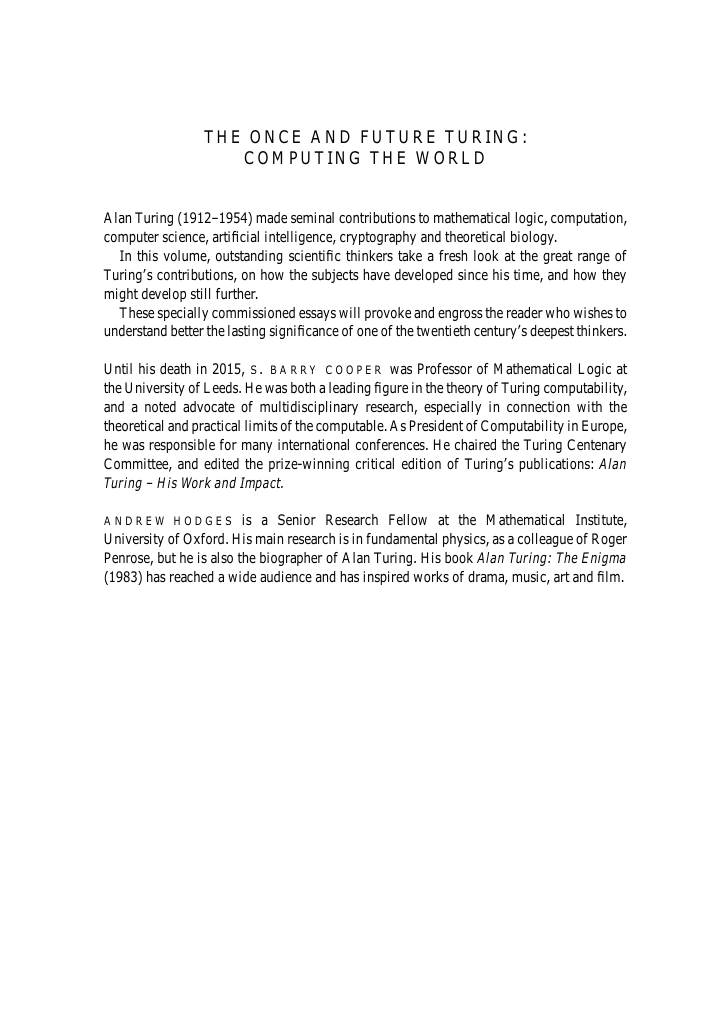

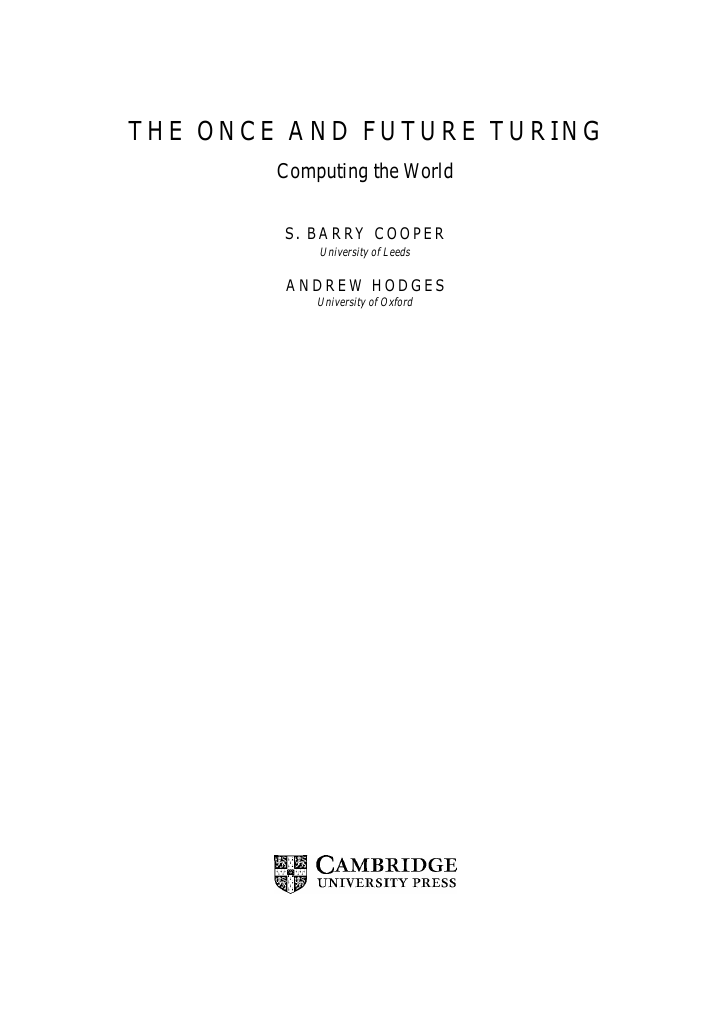


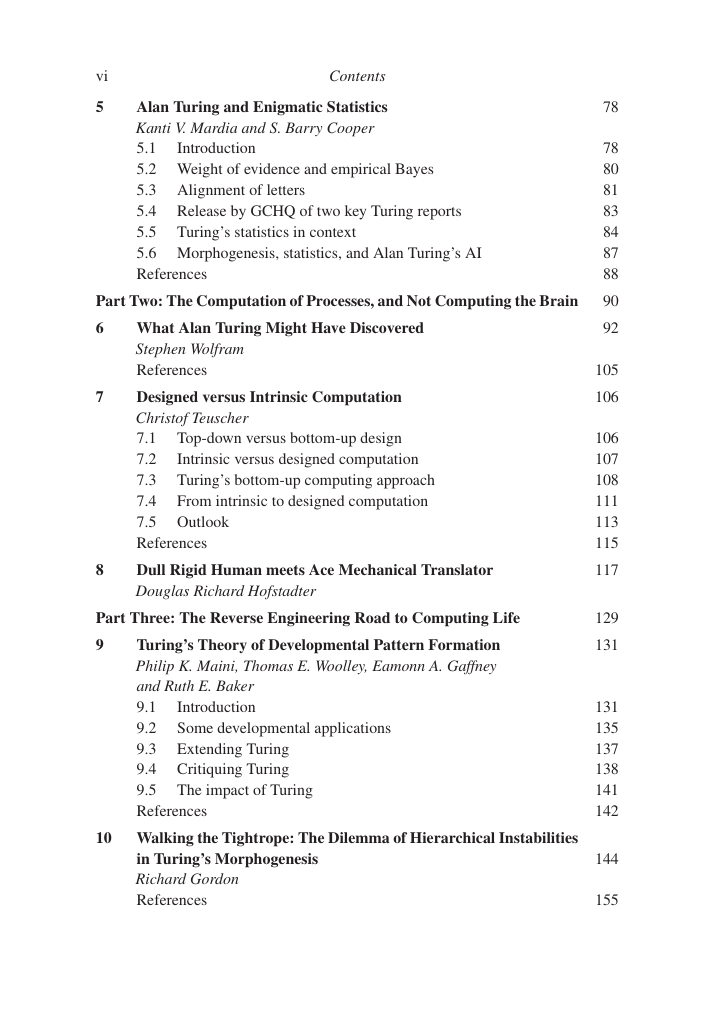
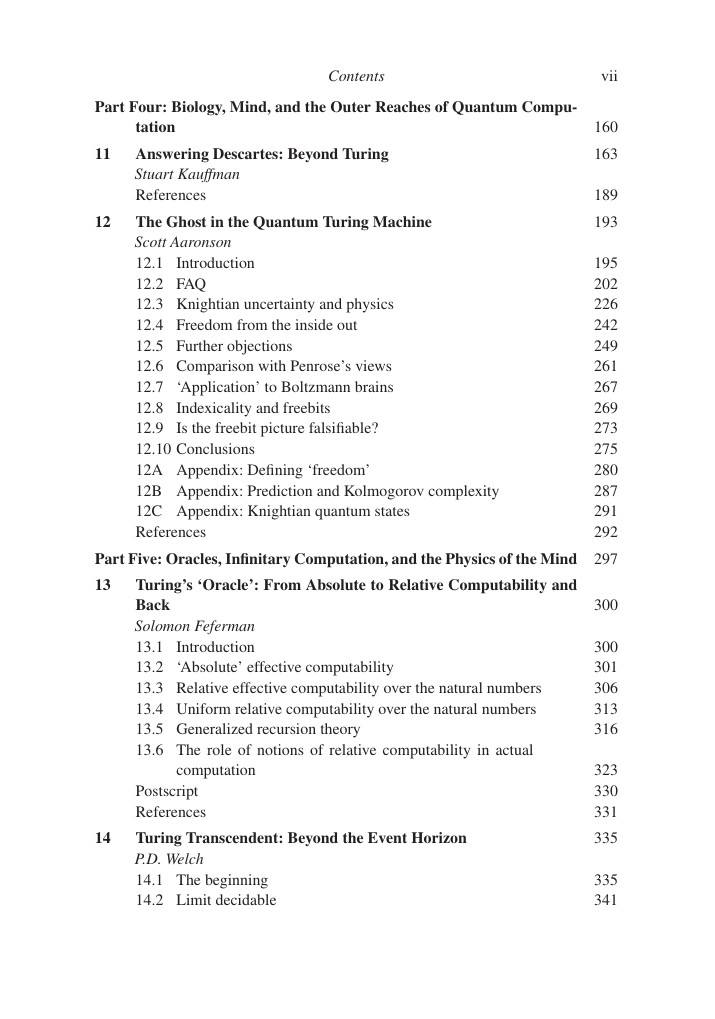
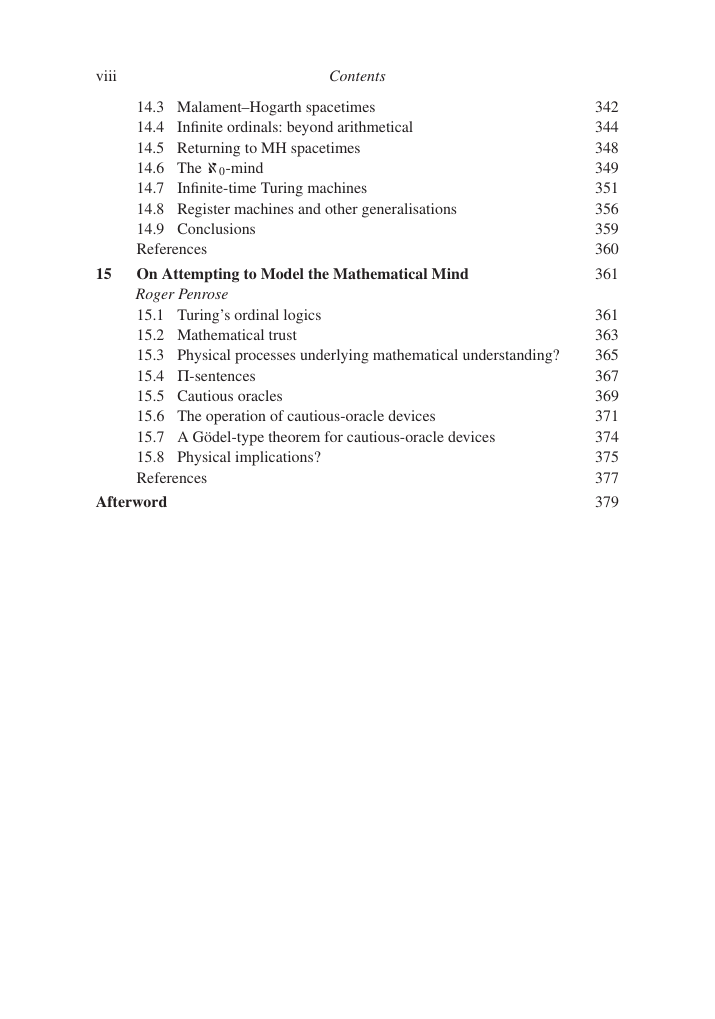








 2023年江西萍乡中考道德与法治真题及答案.doc
2023年江西萍乡中考道德与法治真题及答案.doc 2012年重庆南川中考生物真题及答案.doc
2012年重庆南川中考生物真题及答案.doc 2013年江西师范大学地理学综合及文艺理论基础考研真题.doc
2013年江西师范大学地理学综合及文艺理论基础考研真题.doc 2020年四川甘孜小升初语文真题及答案I卷.doc
2020年四川甘孜小升初语文真题及答案I卷.doc 2020年注册岩土工程师专业基础考试真题及答案.doc
2020年注册岩土工程师专业基础考试真题及答案.doc 2023-2024学年福建省厦门市九年级上学期数学月考试题及答案.doc
2023-2024学年福建省厦门市九年级上学期数学月考试题及答案.doc 2021-2022学年辽宁省沈阳市大东区九年级上学期语文期末试题及答案.doc
2021-2022学年辽宁省沈阳市大东区九年级上学期语文期末试题及答案.doc 2022-2023学年北京东城区初三第一学期物理期末试卷及答案.doc
2022-2023学年北京东城区初三第一学期物理期末试卷及答案.doc 2018上半年江西教师资格初中地理学科知识与教学能力真题及答案.doc
2018上半年江西教师资格初中地理学科知识与教学能力真题及答案.doc 2012年河北国家公务员申论考试真题及答案-省级.doc
2012年河北国家公务员申论考试真题及答案-省级.doc 2020-2021学年江苏省扬州市江都区邵樊片九年级上学期数学第一次质量检测试题及答案.doc
2020-2021学年江苏省扬州市江都区邵樊片九年级上学期数学第一次质量检测试题及答案.doc 2022下半年黑龙江教师资格证中学综合素质真题及答案.doc
2022下半年黑龙江教师资格证中学综合素质真题及答案.doc